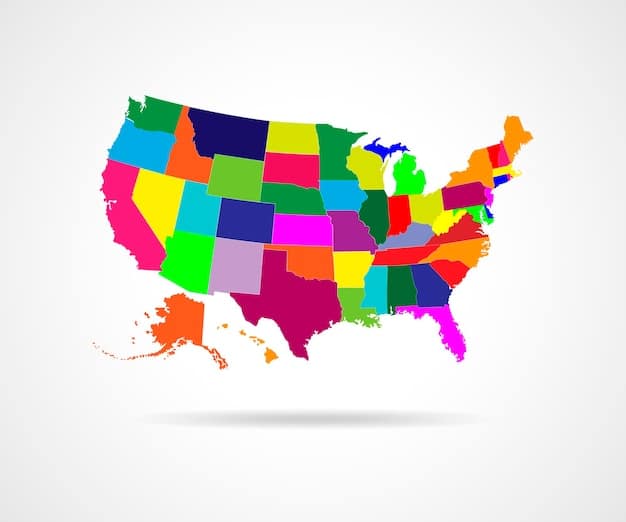Unlocking Regional Streaming: Your 2025 US Content Access Guide

Unlocking Regional Streaming: A 2025 Guide to US Content Access explores methods for accessing geographically restricted content in the US, including VPNs, smart DNS proxies, and account sharing, while navigating the evolving landscape of streaming services and rights agreements to enjoy a wider range of entertainment options.
Navigating the fragmented world of regional streaming in the US can be a challenge. This guide, **Unlocking Regional Streaming: A 2025 Guide to US Content Access**, equips you with the knowledge and tools to access the shows and movies you want, regardless of location.
Understanding Regional Streaming Restrictions in the US
Regional streaming restrictions are commonplace in the US, often due to licensing agreements and distribution rights. This means that content available in one state or region might be unavailable in another. Understanding the ‘why’ behind these restrictions is the first step in finding effective solutions.
Licensing Agreements and Distribution Rights
Streaming services operate under complex licensing agreements. These agreements dictate where and when content can be streamed, often varying by region. The negotiation of these rights is a critical part of streaming service operations.
Content Availability Variations Across States
You might find that a show available on Netflix in California is not available in New York. This discrepancy arises due to localized licensing deals and content testing strategies employed by streaming platforms.

To overcome these restrictions, it’s essential to familiarize yourself with tools and techniques that can provide access to a broader range of streaming content. The following list details key methods to bypass regional limitations.
- Utilize Virtual Private Networks (VPNs) to mask your IP address and appear to be accessing content from a different location.
- Employ Smart DNS proxies, which redirect specific Internet traffic to bypass geographical restrictions without the full encryption of a VPN.
- Consider account sharing with friends or family in different regions, though this can be against the terms of service of some streaming providers.
Understanding the nuances of regional streaming restrictions in the US enables viewers to explore various strategies for accessing geographically restricted content, enhancing their overall streaming experience.
The Role of VPNs in Unlocking Content
VPNs, or Virtual Private Networks, are a powerful tool in the quest to access geographically restricted streaming content. They function by routing your internet traffic through a server in a location of your choice, effectively masking your actual IP address. This makes it appear as though you are browsing from that location.
How VPNs Mask Your IP Address
When you connect to a VPN server, your IP address is replaced with that of the server. This prevents streaming services from detecting your actual location and imposing regional restrictions.
Choosing the Right VPN for Streaming
Not all VPNs are created equal. For streaming, you need a VPN with fast speeds, reliable connections, and servers in the regions you want to access. Look for VPNs that specifically advertise compatibility with popular streaming services.
Using a VPN can unlock a world of content, but it’s important to understand the implications and best practices, as detailed in the following:
- Ensure the VPN has a strict no-logs policy to protect your privacy.
- Check that the VPN offers servers in multiple US locations to bypass specific regional blocks.
- Be aware of potential terms of service violations with streaming providers, as some actively block VPN usage.
VPNs provide a practical solution for unlocking geographically restricted streaming content in the US, but it’s crucial to choose a reliable provider and understand the potential risks involved.
Smart DNS Proxies: A Streaming-Focused Alternative
Smart DNS proxies offer an alternative to VPNs for accessing regional streaming content. Unlike VPNs, they don’t encrypt all your internet traffic, making them potentially faster for streaming. A Smart DNS proxy redirects only the parts of your internet traffic that reveal your location.
How Smart DNS Proxies Bypass Geo-Restrictions
Smart DNS proxies work by redirecting specific DNS requests through servers located in different regions. This tricks streaming services into believing you are accessing their content from an approved location.
Setting Up and Using Smart DNS
Setting up a Smart DNS proxy is generally straightforward. It involves changing the DNS settings on your device or router to point to the Smart DNS server. Most providers offer detailed setup guides for various devices.

For US streaming, Smart DNS proxies can be particularly useful. The following points highlight key advantages and considerations when using Smart DNS:
- They often provide faster streaming speeds compared to VPNs since they don’t encrypt traffic.
- They are generally easier to set up on devices like smart TVs and gaming consoles.
- Like VPNs, some streaming services may block Smart DNS proxies, so check compatibility beforehand.
Smart DNS proxies provide a streamlined solution for accessing geographically restricted streaming content, offering a balance between speed and ease of use.
Legality and Terms of Service Considerations
While using VPNs and Smart DNS proxies to access geographically restricted content is generally legal, it often violates the terms of service of streaming providers. Streaming services actively work to detect and block these tools.
Understanding Streaming Service Terms of Service
Most streaming services’ terms of service explicitly prohibit using VPNs or proxies to bypass regional restrictions. Violating these terms can lead to account suspension or termination.
Potential Risks and Consequences
While legal action against individual users is rare, streaming services can implement measures to block IP addresses associated with VPNs and proxies. This can disrupt your streaming experience.
When considering using these tools, it is important to be aware of the potential consequences. Key considerations include:
- Regularly check streaming service terms of service updates, as policies can change.
- Be prepared for potential service disruptions if your VPN or proxy is detected.
- Consider the ethical implications of bypassing regional restrictions, especially regarding content creators and copyright holders.
While tools like VPNs and Smart DNS offer means to access streaming content beyond your region, understanding the legal and service-related implications is paramount.
Alternative Methods: Account Sharing and More
Apart from VPNs and Smart DNS, alternative methods exist for accessing US streaming content from different regions. Account sharing, though often discouraged, is one such method. Additionally, exploring niche streaming services could offer localized content.
The Pros and Cons of Account Sharing
Account sharing involves using login credentials from someone in another region to access content. While convenient, it violates the terms of service for many platforms and can lead to account restrictions.
Exploring Niche Streaming Services
Several niche streaming services focus on specific genres or regional content. These platforms might offer unique content unavailable on larger services, providing a workaround for regional restrictions.
Exploring alternative methods requires a nuanced approach, keeping in mind the considerations outlined below:
- Account sharing can pose privacy risks, as your viewing history may be visible to the account holder.
- Niche streaming services often have limited content libraries compared to major providers.
- The legality and terms of service implications still apply, even with alternative methods.
Exploring alternative methods, such as carefully considered account sharing or niche streaming services, broadens possibilities for accessing US streaming content, but demands informed and cautious decisions.
The Future of Regional Streaming in the US
The landscape of regional streaming in the US is continuously evolving. As streaming services adapt to combat geo-restrictions, users must stay informed about the latest tools and techniques. Anticipating future trends enables a proactive approach to content access.
Evolving Technologies and Streaming Service Responses
Streaming services are investing in advanced technologies to detect and block VPNs and proxies. This arms race between providers and users will likely continue, leading to more sophisticated methods on both sides.
Predicting Changes in Content Licensing and Distribution
The future may see changes in content licensing agreements, potentially leading to more standardized content availability across regions. However, regional exclusives and testing strategies are likely to persist.
Staying ahead involves careful analysis and preparation. Key recommendations include:
- Monitoring tech news and streaming service updates for the latest developments.
- Adapting your methods as needed, exploring new VPNs, proxies, or alternative services.
- Advocating for fair content access policies to streaming providers and industry groups.
The future of regional streaming in the US is dynamic, demanding vigilance and adaptability as technologies and content distribution strategies evolve.
| Key Point | Brief Description |
|---|---|
| 🌎 Regional Restrictions | Content varies by US region due to licensing agreements. |
| 🛡️ VPNs | Mask your IP to access content from different locations. |
| 🌐 Smart DNS | Redirects specific traffic for faster, geo-unrestricted streaming. |
| ⚖️ Legality | Bypassing restrictions may violate streaming services’ terms. |
Frequently Asked Questions
▼
Streaming content varies primarily due to licensing agreements, where content rights are often negotiated on a region-by-region basis, leading to discrepancies across different US states.
▼
Using a VPN is generally legal, but it often violates the terms of service of streaming providers, potentially leading to account suspension or termination if detected.
▼
A Smart DNS proxy redirects specific internet traffic to bypass geo-restrictions, enabling access to content from different regions without encrypting all traffic, potentially improving streaming speed.
▼
Yes, alternative methods include account sharing (though often discouraged) and exploring niche streaming services that offer localized or unique content not available on major platforms.
▼
Stay informed by monitoring tech news, streaming service updates, and participating in relevant online communities to adapt to the evolving strategies used to combat geo-restrictions.
Conclusion
As you navigate the evolving landscape of US regional streaming in 2025, remember that informed choices and adaptability are key. Armed with insights into VPNs, Smart DNS proxies, and the legal considerations, you’re well-equipped to unlock the content you desire, wherever you are.





